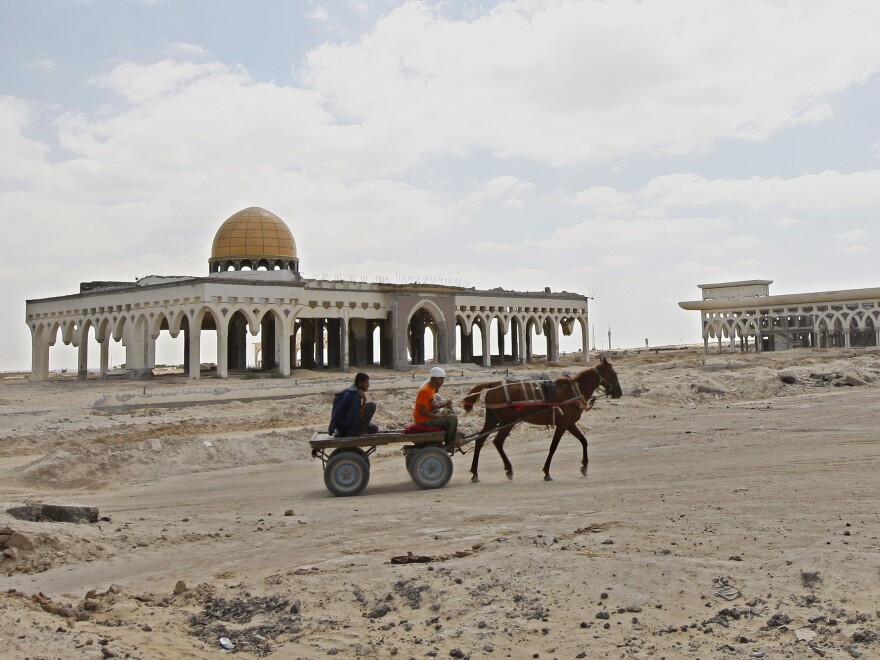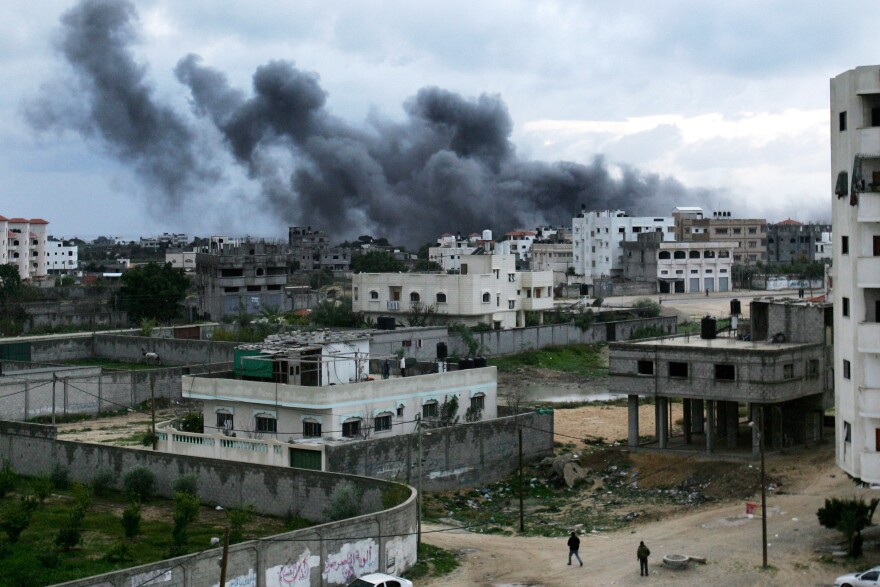TEL AVIV, Israel — It's hard to fathom today. But once the Gaza Strip was calm enough to host a U.S. president, and Palestinian statehood seemed a real possibility.
The day was Dec. 14, 1998, and the mood was upbeat. President Bill Clinton and first lady Hillary Clinton stood next to Palestinian leader Yasser Arafat and his wife to cut the ribbon inaugurating the Gaza International Airport in the southeast corner of the territory.
"Hillary and I, along with Chairman and Mrs. Arafat celebrated a place that will become a magnet for planes from throughout the Middle East and beyond," Clinton said. "A future in which Palestinians can travel directly to the far corners of the world."
For many Palestinians, the airport symbolized the larger effort to establish a Palestinian state that would include Gaza and the West Bank, with a capital in East Jerusalem. By this time, the Israelis and Palestinians had been negotiating for five years under the 1993 Oslo Accords. The start-and-stop process was fitful, but the airport was a tangible sign of what could be.
"It was the story of hope. Many people were optimistic," says Palestinian journalist Taghreed El-Khodary.
"My father and his friends were from the business community. After they visited the airport, my father came to our house, and said, 'Taghreed, it will happen. A Palestinian state is going to happen. Now I believe it.'"
Reporting from Gaza during the rise of Hamas
I traveled from Jerusalem to Gaza on dozens of reporting trips over the next seven years. El-Khodary knew most everyone there and was my guide. She now works as a journalist in Amsterdam, where she lives with her two kids, an 11-year-old daughter and a 10-year-old son, and that's where I reached her.

I would enter Gaza in the north through the Erez Crossing, the same border post Palestinians used to exit Gaza in a bizarre rush-hour scene that began every weekday at precisely 3 a.m.
Tens of thousands of Palestinian workers were allowed into Israel. But they had to pass through stringent Israeli security checks as part of a commute that could last three hours or more each way.
At the stroke of 3, the crossing opened and nighttime stillness turned into rush-hour madness, reflecting the fraught Israeli-Palestinian relations even during those times when they were cooperating.
A big part of the story in the early 2000s was the rise of Hamas, which would become the leading Palestinian faction, surpassing the rival Fatah movement.
Though many Hamas leaders in Gaza were killed by Israeli air strikes over the years, they were shockingly casual about security. El-Khodary would call them up, and then we'd go knock on the front door of their homes.
"We used to sit and have coffee or tea and chat, trying to understand their point of view," she says.
Their view was essentially that Israel should not exist, and they talked about it openly.
Israel withdraws from the territory
In 2005, after a Palestinian uprising, or intifada, that lasted five years, it seemed Gaza might calm down, at least a bit, as Israel withdrew Jewish settlers and troops from the territory after a presence of nearly 40 years.
At that time, El-Khodary was leaving for a year at Harvard in the Nieman Fellowship program for journalists. It was a dramatic change from the confines of Gaza.
"You are exposed to all this freedom of movement and universal values and all of that you learn in American schools," she says. "You get this stimulation and it's just so powerful."

Yet by the time she went back the following year, Gaza was again in turmoil.
The Rafah border crossing between Egypt and the southern end of Gaza was closed. El-Khodary was stuck on the Egyptian side, unable to return home to Gaza — for 39 days.
"It was horrible just to wait. The idea of waiting, waiting and and hoping that the next day it's going to open. It was awful," she says.
Hamas takes over
Something else happened during her time away. The Palestinians held an election — and Hamas won, overtaking Fatah, the dominant Palestinian faction for decades.
It was instantly clear this would have serious consequences. Since then, Israel and Hamas have fought every few years, though the Israeli aim was to weaken the militant group, not to drive it from power or eliminate it entirely.
This included heavy fighting in 2008-2009, with intensive Israeli airstrikes.
"I thought I will lose my life," El-Khodary recalls.

During Israeli airstrikes near her apartment in Gaza City, El-Khodary huddled under a table and made promises to herself.
"One was going to Paris. To go to Paris and to enjoy life," she says.
She did. And then she moved to Amsterdam a year later, in 2010. But her extended family is still in Gaza today and she worries about them constantly.
"I haven't left Gaza because all my family is in Gaza, all my friends. I just learned that my music teacher from elementary school was killed," she says. "It's just so sad that I cannot help them. I used to cover stories. Now my family is in the story."
She wishes they could join her. But flights out of Gaza are a distant memory. The short-lived Gaza International Airport was shut down in 2001 amid fighting.
Today it lies in ruins.
Greg Myre is an NPR national security correspondent who was based in Jerusalem from 2000-2007. Follow him @gregmyre1.
Copyright 2024 NPR



